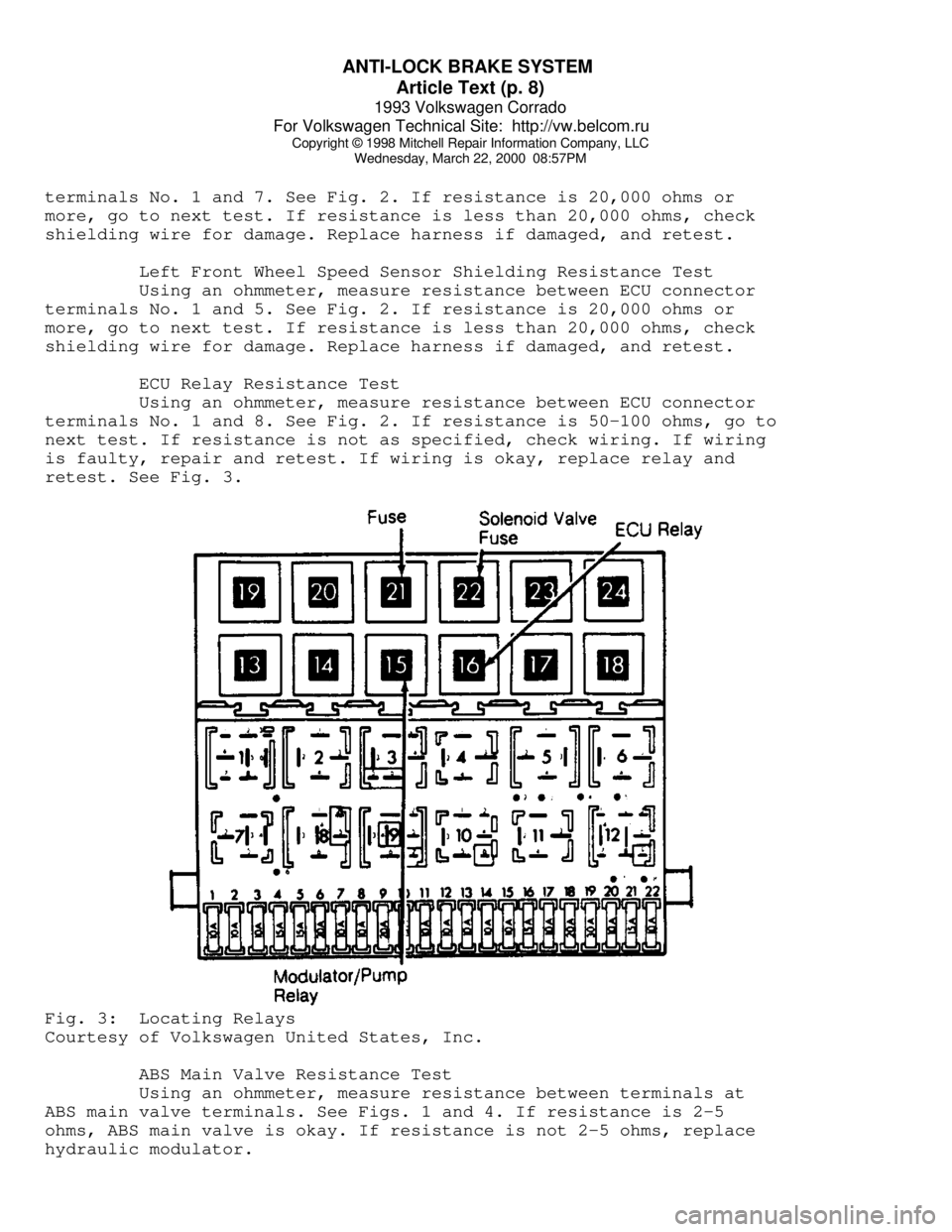VOLKSWAGEN CORRADO 1993 Repair Manual
Manufacturer: VOLKSWAGEN, Model Year: 1993, Model line: CORRADO, Model: VOLKSWAGEN CORRADO 1993Pages: 920, PDF Size: 6.92 MB
Page 411 of 920

ANTI-LOCK BRAKE SYSTEM
Article Text
1993 Volkswagen Corrado
For Volkswagen Technical Site: http://vw.belcom.ru
Copyright © 1998 Mitchell Repair Information Company, LLC
Wednesday, March 22, 2000 08:57PM
ARTICLE BEGINNING
1993 BRAKES
Volkswagen Anti-Lock
Corrado SLC
ANTI-LOCK BRAKE SAFETY PRECAUTIONS
* NEVER open a bleeder valve or loosen a hydraulic line while
ABS is pressurized
* NEVER disconnect or reconnect any electrical connectors while
ignition is on. Damage to ABS control unit may result.
* DO NOT attempt to bleed hydraulic system without first
referring to the appropriate article.
* Only use specially designed brake hoses/lines on ABS-equipped
vehicles.
* DO NOT tap on speed sensor components (sensor, sensor rings).
Speed rings must be pressed, NOT hammered into hubs. Striking
these components can cause demagnetization or a loss of
polarization, affecting the accuracy of the speed signal
returning to the ABS control unit.
* DO NOT mix tire sizes. Increasing the width, as long as tires
remain close to the original diameter, is acceptable. Rolling
diameter must be identical for all 4 tires. Some
manufacturers recommend tires of the same brand, style and
type. Failure to follow this precaution may cause inaccurate
wheel speed readings.
* DO NOT contaminate speed sensor components with grease. Only
use recommended anti-corrosion coating.
* When speed sensor components have been removed, ALWAYS check
sensor-to-ring air gaps when applicable. These specifications
can be found in each appropriate article.
* ONLY use recommended brake fluids. DO NOT use silicone brake
fluids in an ABS-equipped vehicle.
* When installing transmitting devices (CB's, telephones, etc.)
on ABS-equipped vehicles, DO NOT locate the antenna near the
ABS control unit (or any control unit).
* Disconnect all on-board computers, when using electric
welding equipment.
* DO NOT expose the ABS control unit to prolonged periods of
high heat (185øF/85øC for 2 hours is generally considered a
maximum limit).
DESCRIPTION
A Teves Anti-Lock Brake System (ABS) is used. See Fig. 1.
This system reduces the chance of wheel lock-up during heavy braking.
The system consists of 4 wheel speed sensors, Electronic Control Unit
(ECU), hydraulic modulator/pump and solenoid valves, ANTILOCK and
BRAKE warning lights. There are 2 relays located at fuse/relay panel,
Page 412 of 920

ANTI-LOCK BRAKE SYSTEM
Article Text (p. 2)
1993 Volkswagen Corrado
For Volkswagen Technical Site: http://vw.belcom.ru
Copyright © 1998 Mitchell Repair Information Company, LLC
Wednesday, March 22, 2000 08:57PM
to protect the hydraulic modulator and ECU.
NOTE: For more brake system information, see BRAKE SYSTEM
article in the BRAKES section.
OPERATION
When pressure is applied to brake pedal, ECU monitors input
signals from each wheel speed sensor. If ECU measures a rate of
reduction greater than what is programmed in ECU, the ECU will output
a signal to appropriate solenoid valve. Each solenoid valve allows
hydraulic pressure to increase or decrease to the appropriate wheel
cylinder.
If a system failure occurs, ANTILOCK warning light, located
on instrument panel, will come on. System will be deactivated, but
conventional brake system will still operate. If brake fluid level
drops too low, BRAKE warning light, located on instrument panel, will
come on.
CAUTION: See ANTI-LOCK BRAKE SAFETY PRECAUTIONS in this article.
CAUTION: The ABS system is under extremely high pressure. Depressurize
the brake system before loosening or removing any hydraulic
component.
DEPRESSURIZING BRAKE SYSTEM
Turn ignition off. Depress and release brake pedal 25-35
times, or until there is a noticeable increase in the effort to
depress the brake pedal. DO NOT turn ignition on until all hydraulic
lines and components are fully tighten.
BLEEDING BRAKE SYSTEM
FRONT BRAKES
Depressurize brake system. See DEPRESSURIZING BRAKE SYSTEM.
Connect a container with hose to left front bleeder screw. Have
assistant depress and release brake pedal a few times. Holding brake
pedal down, open bleeder screw and allow fluid to enter container.
Close bleeder screw and then release brake pedal. Continue this method
until no air is present in fluid. Check master cylinder fluid level to
make sure it does not go below minimum level mark. Use same procedure
for right front brake.
REAR BRAKES
CAUTION: When bleeding rear brakes, accumulator pressure (about 3100
psi) is used to assist in procedure. Use eye protection when
performing this procedure. DO NOT allow pump to run longer
than 2 minutes. See ANTI-LOCK BRAKE SAFETY PRECAUTIONS in
Page 413 of 920

ANTI-LOCK BRAKE SYSTEM
Article Text (p. 3)
1993 Volkswagen Corrado
For Volkswagen Technical Site: http://vw.belcom.ru
Copyright © 1998 Mitchell Repair Information Company, LLC
Wednesday, March 22, 2000 08:57PM
this article.
Attach hose and container to right rear bleeder screw.
Position actuator lever on load-sensing pressure regulator toward rear
of vehicle. Depress brake pedal and turn ignition on. Open bleeder
screw and allow fluid to exit until no air is present in fluid. Close
bleeder screw. Turn ignition off and release brake pedal. Perform same
procedure for left rear brake. Ensure fluid level does not go below
minimum level mark.Fig. 1: Locating ABS Components
Courtesy of Volkswagen United States, Inc.
ADJUSTMENTS
PARKING BRAKE
Raise vehicle and support securely. Release parking brake
lever. Apply brake pedal once. Loosen lock nuts. Tighten each
adjusting nut until lever on respective caliper lifts off stop.
Measure gap between stop and lever. Do not move lever off stop more
than .040" (1 mm). Tighten lock nuts. Ensure wheels lock at 3 notches.
NOTE: No other information on adjustments is available from
manufacturer.
TROUBLE SHOOTING
Page 414 of 920

ANTI-LOCK BRAKE SYSTEM
Article Text (p. 4)
1993 Volkswagen Corrado
For Volkswagen Technical Site: http://vw.belcom.ru
Copyright © 1998 Mitchell Repair Information Company, LLC
Wednesday, March 22, 2000 08:57PM
HYDRAULIC MODULATOR/PUMP
Depressurize brake system. See DEPRESSURIZING BRAKE SYSTEM.
Turn ignition on. Hydraulic modulator/pump should operate for 60
seconds maximum and then stop. Depress brake pedal a few times; pump
should operate again for a few seconds. If pump motor does not
operate, check electrical system. If pump motor operates for more than
60 seconds, internal or external hydraulic leak may be indicated.
Check for external leaks. If external leak is not found, further
testing may be needed to check for internal leaks.
ANTILOCK WARNING LIGHT
Start engine. ANTILOCK warning light should come on, then
turn off after a few seconds. If light does not come on when engine is
started, check electrical system. If light comes on and stays on,
fault has been detected by the ECU and testing will be needed. See
SYSTEM TESTING under DIAGNOSIS & TESTING.
DIAGNOSIS & TESTING
SYSTEM TESTING
NOTE: Check battery condition, brake fluid level, electrical
connections and wiring for damage. If fluid level is
incorrect or battery and/or electrical connections are
faulty, correct problem before preceding. Perform each step,
in sequence, to test entire system, except for ECU. If
faulty ECU is suspected, replace with a known good one, and
retest system. Unplug ECU connector for all test steps.
Power-To-ECU Test
Turn ignition off. Unplug ECU connector. Turn ignition on.
Using a voltmeter, check voltage between ECU connector terminals No. 1
and 2. See Fig. 2. If voltage is 10 volts or more, go to next test. If
voltage is less than 10 volts, check battery, ground, ABS fuse, relay
and wiring. Repair as necessary.Fig. 2: Identifying ECU Connector Terminals
Courtesy of Volkswagen United States, Inc.
ECU Relay Voltage Test
Connect a jumper wire between ECU connector terminals No. 2
and 8. See Fig. 2. Turn ignition on. Using a voltmeter, check voltage
between ECU connector terminals No. 1 and 3. If voltage is 10 volts or
more, go to next test. If voltage is less than 10 volts, check ABS
Page 415 of 920

ANTI-LOCK BRAKE SYSTEM
Article Text (p. 5)
1993 Volkswagen Corrado
For Volkswagen Technical Site: http://vw.belcom.ru
Copyright © 1998 Mitchell Repair Information Company, LLC
Wednesday, March 22, 2000 08:57PM
fuse. If fuse is faulty, replace and retest. If fuse is okay, check
wiring. If wiring is faulty, repair and retest. If wiring is okay,
replace relay and retest.
Brakelight Switch
Turn ignition on. Apply brakes. Check for 12 volts between
terminals No. 12 and 1. If 12 volts are present, brakelight switch is
okay. If 12 volts are not present, check fuse, brakelight switch and
Black/Red wire from brakelight switch to ECU.
Hydraulic Modulator/Pump Relay Voltage Test
1) Turn ignition off. Unplug hydraulic modulator/pump
connector. Depress brake pedal 25 times. Turn ignition on. Using a
voltmeter, measure voltage between ECU connector terminals No. 1 and
32. See Fig. 2. If voltage is 10 volts or more, go to RIGHT REAR WHEEL
SPEED SENSOR VOLTAGE TEST under SYSTEM TESTING.
2) If voltage is less than 10 volts, check hydraulic
modulator/pump fuse. If fuse is okay, check wiring between ECU
connector terminal No. 32 and hydraulic modulator/pump connector
terminal No. 1 (large gauge Red/Black wire). See Figs. 2 and 4. If
wiring is not okay, repair wiring, and retest. If wiring is okay,
replace relay, and retest.
Right Rear Wheel Speed Sensor Voltage Test
Connect an AC voltmeter between ECU connector terminals No. 4
and 22. See Fig. 2. Rotate right rear wheel at one revolution per
second. Measure voltage with wheel rotating. If voltage is 0.075 volt
or more, go to next test. If voltage is less than 0.075 volt, check
wheel speed sensor and/or toothed ring for damage, wear and proper
installation. If damage or wear is found, replace faulty component and
retest. If components are not properly installed, reposition and
retest. If components are okay, replace wheel speed sensor and retest.
Left Rear Wheel Speed Sensor Voltage Test
Connect an AC voltmeter between ECU connector terminals No. 6
and 24. See Fig. 2. Rotate left rear wheel at one revolution per
second. Measure voltage with wheel rotating. If voltage is 0.075 volt
or more, go to next test. If voltage is less than 0.075 volt, check
wheel speed sensor and/or toothed ring for damage, wear and proper
installation. If damage or wear is found, replace faulty component and
retest. If components are not properly installed, reposition and
retest. If components are okay, replace wheel speed sensor and retest.
Right Front Wheel Speed Sensor Voltage Test
Connect an AC voltmeter between ECU connector terminals No. 7
and 25. See Fig. 2. Rotate right front wheel at one revolution per
second. Measure voltage with wheel rotating. If voltage is 0.075 volt
or more, go to next test. If voltage is less than 0.075 volt, check
wheel speed sensor and/or toothed ring for damage, wear and improper
installation. If damage or wear is found, replace faulty component,
and retest. If components are improperly installed, reposition
component, and retest. If components are okay, replace wheel speed
Page 416 of 920

ANTI-LOCK BRAKE SYSTEM
Article Text (p. 6)
1993 Volkswagen Corrado
For Volkswagen Technical Site: http://vw.belcom.ru
Copyright © 1998 Mitchell Repair Information Company, LLC
Wednesday, March 22, 2000 08:57PM
sensor, and retest.
Left Front Wheel Speed Sensor Voltage Test
Connect an AC voltmeter between ECU connector terminals No. 5
and 23. See Fig. 2. Rotate left front wheel at one revolution per
second. Measure voltage with wheel rotating. If voltage is 0.075 volt
or more, go to next test. If voltage is less than 0.075 volt, check
wheel speed sensor and/or toothed ring for damage, wear and proper
installation. If damage or wear is found, replace faulty component and
retest. If components are not properly installed, reposition and
retest. If components are okay, replace wheel speed sensor and retest.
ECU Relay Continuity Test
Turn ignition off. Using an ohmmeter, check for continuity
between ECU connector terminals No. 1 and 3, and between terminals No.
1 and 20. See Fig. 2. If there is continuity at both test points, go
to next test. If there is no continuity at either or both test points,
check wiring. If wiring is faulty, repair and retest. If wiring is
okay, replace relay and retest.
Solenoid Valves Ground Circuit Continuity Test
1) Turn ignition off. Remove jumper wire from previous test.
Using an ohmmeter, check for continuity between ECU connector
terminals No. 1 and 11. See Fig. 2. If there is continuity, go to step
3).
2) If continuity does not exist, check for continuity between
ECU connector terminal No. 1 and valve block housing and between
hydraulic modulator and valve block housing. If continuity does not
exist between ECU connector terminal No. 1 and valve block housing,
repair wiring, and retest. If continuity does not exist between
housings, repair as necessary.
3) Reconnect jumper wire between ECU connector terminals No.
1 and 11. Check for continuity between ECU connector terminal No. 11
and valve block connector terminal No. 1 (Brown wire). See Figs. 2 and
4. If there is no continuity, repair wiring and retest.
Hydraulic Modulator/Pump Relay Ground Circuit Test
Turn ignition off. Reconnect pressure switch connector.
Depress brake pedal 20 times. Using an ohmmeter, check for continuity
between ECU connector terminals No. 1 and 14. If continuity exists, go
to next test. If continuity does not exist, check for continuity
between pressure switch terminals No. 1 (Brown wire) and No. 4
(Red/Yellow or White wire). See Figs. 1 and 4. If continuity does not
exist, replace pressure switch, and retest. If continuity exists,
check wiring between ECU terminal No. 14 and pressure switch terminal
No. 4. Repair wiring, and retest.
Low Pressure Warning Switch Test
Turn ignition off. Ensure brake fluid level is okay and fluid
level sensor switch float is in correct position (switch is in closed
position). Ensure accumulator is fully charged and pump is not
operating. Using an ohmmeter, check for continuity between ECU
Page 417 of 920

ANTI-LOCK BRAKE SYSTEM
Article Text (p. 7)
1993 Volkswagen Corrado
For Volkswagen Technical Site: http://vw.belcom.ru
Copyright © 1998 Mitchell Repair Information Company, LLC
Wednesday, March 22, 2000 08:57PM
connector terminals No. 9 and 10. See Fig. 2. If there is continuity,
switch is okay. If continuity does not exist, check wiring. If wiring
is okay, replace switch, and retest.
Right Rear Wheel Speed Sensor Resistance Test
Turn ignition off. Using an ohmmeter, measure resistance
between ECU connector terminals No. 4 and 22. See Fig. 2. If
resistance is 800-1400 ohms, go to next test. If resistance is not as
specified, check resistance at right rear wheel speed sensor. If
resistance is correct, repair wiring and retest. If resistance is not
correct, replace wheel speed sensor and retest.
Left Rear Wheel Speed Sensor Resistance Test
Using an ohmmeter, measure resistance between ECU connector
terminals No. 6 and 24. See Fig. 2. If resistance is 800-1400 ohms, go
to next test. If resistance is not as specified, check resistance at
left rear wheel speed sensor. If resistance is correct, repair wiring
and retest. If resistance is not correct, replace wheel speed sensor,
and retest.
Right Front Wheel Speed Sensor Resistance Test
Using an ohmmeter, measure resistance between ECU connector
terminals No. 7 and 25. See Fig. 2. If resistance is 800-1400 ohms, go
to next test. If resistance is not as specified, check resistance at
right front wheel speed sensor. If resistance is correct, repair
wiring and retest. If resistance is not correct, replace wheel speed
sensor and retest.
Left Front Wheel Speed Sensor Resistance Test
Using an ohmmeter, measure resistance between ECU connector
terminals No. 5 and 23. See Fig. 2. If resistance is 800-1400 ohms, go
to next test. If resistance is not as specified, check resistance at
left front wheel speed sensor. If resistance is correct, repair
wiring, and retest. If resistance is not correct, replace wheel speed
sensor, and retest.
Right Rear Wheel Speed Sensor Shielding Resistance Test
Using an ohmmeter, measure resistance between ECU connector
terminals No. 1 and 4. See Fig. 2. If resistance is 20,000 ohms or
more, go to next test. If resistance is less than 20,000 ohms, check
shielding wire for damage. Replace harness if damage is found and
retest.
Left Rear Wheel Speed Sensor Shielding Resistance Test
Using an ohmmeter, measure resistance between ECU connector
terminals No. 1 and 6. See Fig. 2. If resistance is 20,000 ohms or
more, go to next test. If resistance is less than 20,000 ohms, check
shielding wire for damage. Replace harness if damage is found and
retest.
Right Front Wheel Speed Sensor Shielding Resistance Test
Using an ohmmeter, measure resistance between ECU connector
Page 418 of 920

ANTI-LOCK BRAKE SYSTEM
Article Text (p. 8)
1993 Volkswagen Corrado
For Volkswagen Technical Site: http://vw.belcom.ru
Copyright © 1998 Mitchell Repair Information Company, LLC
Wednesday, March 22, 2000 08:57PM
terminals No. 1 and 7. See Fig. 2. If resistance is 20,000 ohms or
more, go to next test. If resistance is less than 20,000 ohms, check
shielding wire for damage. Replace harness if damaged, and retest.
Left Front Wheel Speed Sensor Shielding Resistance Test
Using an ohmmeter, measure resistance between ECU connector
terminals No. 1 and 5. See Fig. 2. If resistance is 20,000 ohms or
more, go to next test. If resistance is less than 20,000 ohms, check
shielding wire for damage. Replace harness if damaged, and retest.
ECU Relay Resistance Test
Using an ohmmeter, measure resistance between ECU connector
terminals No. 1 and 8. See Fig. 2. If resistance is 50-100 ohms, go to
next test. If resistance is not as specified, check wiring. If wiring
is faulty, repair and retest. If wiring is okay, replace relay and
retest. See Fig. 3.Fig. 3: Locating Relays
Courtesy of Volkswagen United States, Inc.
ABS Main Valve Resistance Test
Using an ohmmeter, measure resistance between terminals at
ABS main valve terminals. See Figs. 1 and 4. If resistance is 2-5
ohms, ABS main valve is okay. If resistance is not 2-5 ohms, replace
hydraulic modulator.
Page 419 of 920

ANTI-LOCK BRAKE SYSTEM
Article Text (p. 9)
1993 Volkswagen Corrado
For Volkswagen Technical Site: http://vw.belcom.ru
Copyright © 1998 Mitchell Repair Information Company, LLC
Wednesday, March 22, 2000 08:57PM
ABS Main Valve Continuity Test
Using an ohmmeter, check for continuity between ABS main
valve terminal No. 1 (Black wire) and ECU connector terminal No. 18,
and between ABS main valve terminal No. 2 (Brown wire) and ground.
There should be continuity at both test points. If there is no
continuity at both test points, repair wiring and retest.
Rear Hydraulic Modulator Inlet Valve Resistance Test
Using an ohmmeter, measure resistance between ECU connector
terminals No. 11 and 17. See Fig. 2. If resistance is 5-7 ohms, go to
next test. If resistance is not 5-7 ohms, measure between hydraulic
modulator block terminals No. 1 (Brown wire) and No. 5 (Gray wire).
See Fig. 4. If resistance is 5-7 ohms, check wiring between hydraulic
modulator and ECU for open circuit. If resistance is not 5-7 ohms,
replace hydraulic modulator.
Right Front Hydraulic Modulator Inlet Valve Resistance Test
Using an ohmmeter, measure resistance between ECU connector
terminals No. 11 and 15. See Fig. 2. If resistance is 5-7 ohms, go to
next test. If resistance is not 5-7 ohms, measure between hydraulic
modulator terminals No. 1 (Brown wire) and No. 2 (Yellow wire). See
Fig. 4. If resistance is 5-7 ohms, check wiring between hydraulic
modulator and ECU for open circuit. If resistance is not 5-7 ohms,
replace hydraulic modulator.
Left Front Hydraulic Modulator Inlet Valve Resistance Test
Using an ohmmeter, measure resistance between ECU connector
terminals No. 11 and 35. See Fig. 2. If resistance is 5-7 ohms, go to
next test. If resistance is not 5-7 ohms, measure between hydraulic
modulator terminals No. 1 (Brown wire) and No. 7 (Blue or Black/Green
wire). See Fig. 4. If resistance is 5-7 ohms, check wiring between
valve block and ECU for open circuit. If resistance is not 5-7 ohms,
replace hydraulic modulator.
Rear Hydraulic Modulator Outlet Valve Resistance Test
Using an ohmmeter, measure resistance between ECU connector
terminals No. 11 and 33. See Fig. 2. If resistance is 3-5 ohms, go to
next test. If resistance is not 3-5 ohms, measure between valve block
terminals No. 1 (Brown wire) and No. 4 (White wire). See Fig. 4. If
resistance is 3-5 ohms, check wiring between hydraulic modulator and
ECU for open circuit. If resistance is not 3-5 ohms, replace hydraulic
modulator.
Right Hydraulic Modulator Block Outlet Valve Resistance Test
Using an ohmmeter, measure resistance between ECU connector
terminals No. 11 and 34. See Fig. 2. If resistance is 3-5 ohms, go to
next test. If resistance is not 3-5 ohms, measure between hydraulic
modulator terminals No. 1 (Brown wire) and No. 3 (Green wire). See
Fig. 4. If resistance is 3-5 ohms, check wiring between hydraulic
modulator and ECU for open circuit. If resistance is not 3-5 ohms,
replace hydraulic modulator.
Page 420 of 920

ANTI-LOCK BRAKE SYSTEM
Article Text (p. 10)
1993 Volkswagen Corrado
For Volkswagen Technical Site: http://vw.belcom.ru
Copyright © 1998 Mitchell Repair Information Company, LLC
Wednesday, March 22, 2000 08:57PM
Left Front Hydraulic Modulator Outlet Valve Resistance Test
Using an ohmmeter, measure resistance between ECU connector
terminals No. 11 and 16. See Fig. 2. If resistance is 3-5 ohms, go to
next test. If resistance is not 3-5 ohms, measure between hydraulic
modulator terminals No. 1 (Brown wire) and No. 6 (Black/Blue wire).
See Fig. 4. If resistance is 3-5 ohms, check wiring between hydraulic
modulator and ECU for open circuit. If resistance is not 3-5 ohms,
replace hydraulic modulator.
Hydraulic Modulator/Pump Relay Resistance Test
Turn ignition off. Unplug pressure switch connector from
hydraulic modulator. Using an ohmmeter, measure resistance between ECU
connector terminals No. 2 and 14. See Fig. 2. If resistance is 50-100
ohms, go to next test. If resistance is not 50-100 ohms, check wiring.
If wiring is faulty, repair wiring and retest. If wiring is okay,
replace relay and retest.
ABS Main Valve Function Test
Connect a jumper wire between ECU connector terminals No. 2
and 18. See Fig. 2. Depress brake pedal. Turn ignition on. Brake pedal
should rise slightly. If brake pedal did not rise slightly, check
wiring between terminals and hydraulic modulator. If wiring is okay,
replace hydraulic modulator.
Hydraulic Modulator/Pump Test
Turn ignition off. Depress brake pedal 25 times. Turn
ignition on. BRAKE and ANTILOCK lights should come on for 2-60
seconds. Pump should operate for 2-60 seconds, then turn off. If
lights do not come on, check wiring and warning light bulbs, and
retest. Also check bulb(s). If lights come on, then turn off, and pump
operates for 60 seconds maximum, then turns off, go to next test. If
pump does not operate and all other preceding tests have been
performed, replace hydraulic modulator/pump.
CAUTION: During VALVE BLOCK FUNCTION TESTS, DO NOT turn ignition on
longer than 60 seconds during any test.
Rear Valve Block Function Test
Connect a jumper wire ECU between ECU connector terminals No.
2, 17 and 33. See Fig. 2. Depress brake pedal. Rear wheels should be
locked up. Turn ignition on. Rear wheels should rotate. If wheels do
not rotate, replace hydraulic modulator. Turn ignition off.
Right Front Valve Block Function Test
Connect a jumper wire ECU between ECU connector terminals No.
2, 15 and 34. See Fig. 2. Depress brake pedal. Right front wheel
should be locked up. Turn ignition on. Right front wheel should
rotate. If wheel does not rotate, replace hydraulic modulator. Turn
ignition off.
Left Front Valve Block Function Test